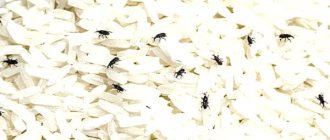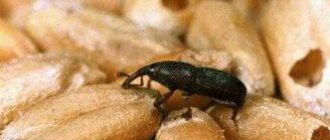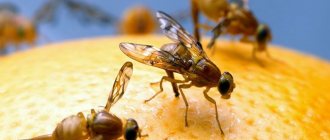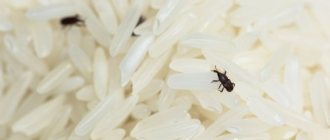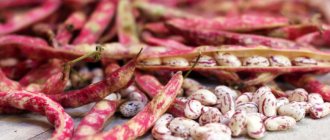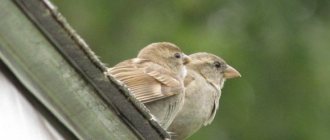The weevil beetle boasts a very ancient history, because the first mentions of it were found in Ancient Egypt. Even then, he penetrated the pharaohs' vaults and destroyed supplies. Despite the fact that it mainly prefers tropical climates, some of its species thrive in more severe conditions. Over the centuries, it has not lost its activity and in our time often appears as a place where various products are stored. Therefore, it is important to know how to deal with it and how to prevent its occurrence.
Description of the pest
It is quite difficult to see what a weevil looks like, because the size of an adult individual is on average 3.5 mm. At the initial stage of its development it is colored light brown, but as it grows it becomes very dark in color. And it got its name from a special elongated rostrum that crowns its body, which resembles a cylinder in shape. The weevil insect cannot fly, but it moves very quickly with the help of its legs.
A distinctive feature of this species is its very powerful jaws, so weevils in an apartment or warehouse can easily destroy the integrity of the packaging material and get to the food. For their comfortable existence, they need a temperature from 10°C to 25°C, humidity within 65%, as well as the humidity of the products themselves (grains) about 15%.
The female gnaws “burrows” in the grains and lays eggs there, from which larvae emerge two weeks later. As they develop, they eat the grain from the inside and pupate. The hatched bug gnaws through the wall and ends up outside. It is precisely because of this method of development that pests are very difficult to detect at an early stage. Adult individuals become noticeable.
Apple flower beetle
The most famous and dangerous pest in our gardens, it has chosen the apple tree for life, and less often settles on the pear tree. A brownish-gray beetle about 4 mm long with a thin, curved proboscis overwinters in cracks in the bark, under the leaves.
In early spring, at an average daily temperature of 6°C, it emerges from its shelter and moves into the trees. At first it feeds on the kidneys, making punctures; as a result, “crying kidneys” can be seen on them - droplets of clear liquid.
Then the time comes to lay eggs; for this, the females gnaw holes in the flower buds and lay one egg in each bud. The larvae, hatching from the eggs, gnaw out the contents of the buds and fill them with waste products.
Buds damaged by apple blossom beetle. Photo by the author
Unopened petals dry out, forming brown caps under which larvae or pupae hide. A new generation of beetles feeds on the leaves, gnawing small holes in them, and spreads throughout the garden.
Particularly great damage from the flower beetle is felt in years with weak flowering of the apple tree; in this case, the apple harvest may not be expected.
Types of pest bugs
There are a great many species of these pest beetles, and all of them are not only resistant to various changes in the environment, but also absolutely omnivorous. The main types of domestic weevils that may end up in our apartments include the following:
- The granary weevil lives in the grain. This small brown bug has a very good appetite and, multiplying quickly, is capable of infecting a warehouse with cereals and flour in a very short time;
A relative of the granary weevil is the rice weevil. It is a little smaller in size, but causes massive damage. The main part of his diet consists of cereals, corn, peas, pasta, crackers;- As the name implies, the nut pest with a proboscis causes the main damage to its stock of hazels and walnuts. Having made a hole in the shell, the female lays eggs, from which larvae emerge and destroy the kernels;
- The oak variety is also quite large.
The varieties and types of weevils are very extensive, and, unfortunately, no one is safe from their appearance in the apartment. Even if your kitchen is sparkling clean, you may still be bringing in contaminated food from the store.
Professional pest control
If you can’t get rid of weevils on your own or they have infested your home too much, you should contact a special service. In this case, you can be sure that pests will be destroyed in all possible places of residence. The methods used by exterminators to combat insects are as follows:
- The cold fog method works on the principle of mixing pesticide vapors, which are cooled in a generator and mixed with air. A kind of fog is formed, which settles on all objects that have been infected.
- The hot steam method is most effective for large warehouses. Here they use hot steam, gasoline or gas.
- Barrier protection is used to block all possible cracks through which weevils could enter the stock. Typically, this method is used as the primary one.
Weevil control measures
You can get rid of weevils in the kitchen, the main thing is to do it as soon as you discover these uninvited guests in your products. Use the following tips and the fight against weevil will be successful:
If you notice at least one bug, then you need to carefully check everything: cereals, pasta and even tea. Contaminated products should be immediately disposed of in the garbage disposal;- Those products that are close to the source of infection must be protected. To do this, you can influence them with temperature. Low rates are dangerous for all stages of development of this insect, so you can put the packs in the freezer for a couple of days or, if it’s frosty outside, on the balcony. Or you can heat the cereal in the oven. It will be enough to keep the products there for several hours at 60°C;
- After you have found a weevil in cereals and got rid of the affected products, be sure to wipe all the shelves and walls of the cabinet with soapy water, and then thoroughly treat all surfaces with table vinegar diluted with water.
These measures are very simple and do not cause any difficulties. However, they are an integral part of pest control. After carrying out these activities, you will be able to use both special chemicals and folk tips for destroying the weevil.
Why is it dangerous?
Weevils can reproduce very quickly in comfortable home conditions. One female can lay up to 300 eggs during her life. Their colonies spread throughout all bulk products in the kitchen. Weevil pests pierce containers with groceries with their “proboscis” and poison food with their excrement. Insect waste products can cause allergic reactions and eating disorders.
Important! Weevils are carriers of fungal and bacterial infections.
It is extremely difficult to notice the first stage of infection. You may find small stuck together lumps in the flour. In buckwheat, peas, and beans, whitish pellets are visible, indicating the presence of pests.
Rice elephant
Chemicals against weevils
If you are wondering how to deal with weevils, you need to consider that any drugs that you are going to use must be absolutely safe for humans. This is due to the fact that insects live directly in the products. And installing any traps or simply placing drugs on shelves are ineffective methods.
But the omnivorous weevil can also attack indoor plants. These pests chew holes in the buds and lay eggs there. As a result of such destructive activity, the plant weakens and begins to hurt. And insects, having multiplied, can reach your kitchen.
To prevent the spread of the weevil in the apartment, we first get rid of the damaged parts of the plant, and then we treat the soil and leaves with solutions of products such as Inta-Virom or Fufanon.
Mr. Summer resident advises: preventive measures
To prevent its occurrence, you can take a number of preventive actions, which are as follows:
- Clear the area of leaves and unnecessary branches in a timely manner.
- Cultivate the soil near the trees systematically.
- Plant repellent plants near growing crops, such as wormwood.
- Using lime, treat trees.
- Promote the appearance of birds that love beetles with the help of birdhouses, hanging them on trees.
- Periodically treat with a harmless special product, for example Fitoverm.
- Grow away from wild crops.
- In the spring, when the buds appear, the elephants should be shed, and hunting belts will become excellent helpers.
- Alternate sowing of crops.
A comprehensive and timely impact on the weevil will lead to the desired result: the beetle will be defeated.
How to get rid of weevils using folk remedies
You can also learn how to get rid of weevils from folk advice. Most of them advise placing on shelves plants such as lavender, tansy, bay leaf, wormwood, which have a strong odor. Cloves and mint will do.
It's good if you have an extract, for example, lavender. Then you can soak a cotton pad in it and leave it on the shelf. Citrus peel, mint, eucalyptus and even washing powder have a deterrent effect. Unpeeled garlic cloves can be placed directly into the container.
You can repel insects and remove weevils by treating possible places where they appear with a mixture of kerosene, ammonia, liquid soap and turpentine, taken in equal proportions.
Preventive methods
Preventive methods are necessary in order to eliminate the risk of re-appearance of “uninvited guests” in your home. So, the first thing to remember is not to make large stocks of cereals. You should keep no more than a month's supply. The longer the cereal sits in your house, the higher the likelihood of weevils appearing in food.
The second preventive method is to decompose all cereals into separate bags and store them in different places (for example, on different shelves). After purchasing cereals, you can place them in the freezer for a day as a preventive measure, and then put them on a shelf intended for storing food.
Use airtight containers to store cereals and be sure to monitor the expiration date of the product.
The kitchen should always be clean and tidy. If you spill something, immediately clean up after yourself. Once a week, wipe all shelves with soapy water or adding a drop of aromatic oil.
You can also place garlic cloves, cloves and other fragrant plants on the shelves.
Ventilate food - this is also an important rule of prevention. If you follow all these basic rules, then there will be nothing left for pests to leave your home, since you will deprive them of food and will also drive away pungent odors from your apartment
Tips and tricks for storing cereals
- Capacity. Avoid disposable bags. They are easy to chew through. Try to use sealed containers or plastic. Before pouring the cereal into the container, be sure to rinse it. You can even use soap or dishwashing detergent. Wait for the cereal to dry completely and pour it into the prepared container.
- Purity. Keep your kitchen shelves clean.
